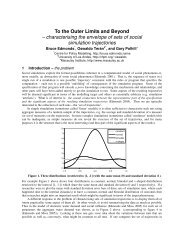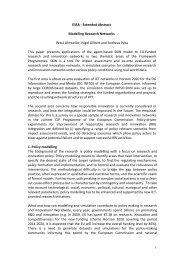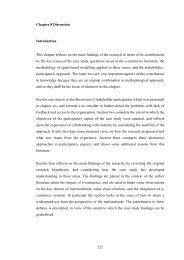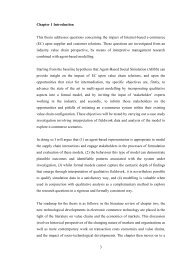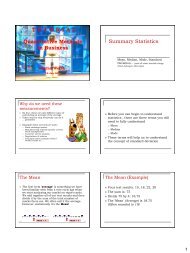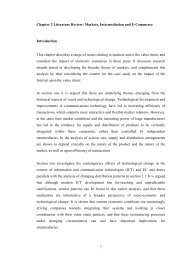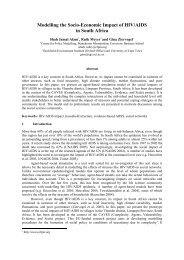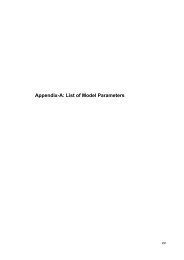1 Agent-Based Modelling Incorporating Qualitative and Quantitative ...
1 Agent-Based Modelling Incorporating Qualitative and Quantitative ...
1 Agent-Based Modelling Incorporating Qualitative and Quantitative ...
Create successful ePaper yourself
Turn your PDF publications into a flip-book with our unique Google optimized e-Paper software.
1319 units). Although five intermediaries manage sales volumes of greater than 500 units, there is<br />
markedly greater inequality in this distribution: the majority have sales of less than 200. This<br />
inequality is also reflected in the result that there is one intermediary casualty: intermediary-2<br />
survives only up until TC19. The largest intermediary also makes a profit of more than 18,795 in<br />
TC100, compared to 15,190 (an increase of 24%) in the first scenario. In fact, Figure 8 shows a<br />
sharp decline in profits for many distributors, whereas other distributors grow quickly in terms of<br />
profitability. Intermediary-18 is the most visible example of this: starting with a very low<br />
profitability in the early part of the simulation, int-18 overtakes many other distributors that are<br />
experiencing declining profits, rapidly increases to a profitability of more than 15,000 by cycle 20,<br />
<strong>and</strong> becomes the most profitable intermediary in TC27. This demonstrates an interesting dynamic<br />
resulting from the customer referrals process – intermediaries experience highly changeable<br />
fortunes in the early part of the simulation, which eventually result in a very different state from the<br />
initial one. In comparison with S1, this suggests greater short to medium-term variation.<br />
The path of adoption of Internet-EC is virtually identical to that of the first scenario: high adoption<br />
amongst direct customers but low adoption amongst customers supplied via distribution. The extent<br />
of the market domination by few large distributors in these simulations clearly gives us an<br />
important result: it suggests that customer referrals leads to more distributor inequality compared to<br />
manufacturer referrals (i.e. scenario one). As all other parameters were exactly the same, this result<br />
must be attributed to the specification of communication processes: customer-to-customer ‘word of<br />
mouth’ communication results in large majorities of customers choosing the same (few) suppliers.<br />
In the simulation results shown in Figure 9 below, where we do specify endorsements, we find that<br />
the number of customers via distribution reaches a maximum of 260 agents in TC100. This is<br />
approximately three times as many as in the case without endorsements (83) or in S1 (109), whilst<br />
the number of direct adopters is approximately the same. This suggests the increase in<br />
intermediated customers adopting must be attributed to the communication of endorsements during<br />
those interactions. Our conclusion is that the specification of communication of endorsements<br />
information drives the high level of adoption: through customer-to-customer persuasion<br />
25




